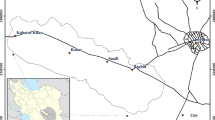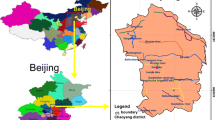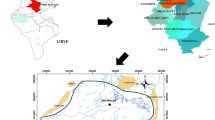Abstract
The assessment of groundwater vulnerability to pollution has proved to be an effective tool for the delineation of protection zones in areas affected by groundwater contamination due to intensive fertilizer applications. By modifying and optimizing the well known and widely used DRASTIC model it was possible to predict the intrinsic vulnerability to pollution as well as the groundwater pollution risk more accurately. This method incorporated the use of simple statistical and geostatistical techniques for the revision of the factor ratings and weightings of all the DRASTIC parameters under a GIS environment. The criterion for these modifications was the correlation coefficient of each parameter with the nitrates concentration in groundwater. On the basis of their statistical significance, some parameters were subtracted from the DRASTIC equation, while land use was considered as an additional DRASTIC parameter. Following the above-mentioned modifications, the correlation coefficient between groundwater pollution risk and nitrates concentration was considerably improved and rose to 33% higher than the original method. The model was applied to a part of Trifilia province, Greece, which is considered to be a typical Mediterranean region with readily available hydrogeological and hydrochemical data.
Résumé
L’évaluation de la vulnérabilité des eaux souterraines à la pollution a montré qu’elle est un outil efficace pour délimiter les zones de protection dans les zones affectées par la contamination des eaux souterraines due à l’utilisation intensive de fertilisants. En modifiant et optimisant le modèle DRASTIC, bien connu et souvent utilisé, il a été possible de prédire la vulnérabilité intrinsèque à la pollution, et de définir plus précisément le risque de pollution. Cette méthode incorpore l’utilisation de simples techniques statistiques et géostatistiques, pour la révision des facteurs d’estimation et de pondération de tous les paramètres de DRASTIC sous S.I.G. Le critère de ces modifications était le coefficient de corrélation de chaque paramètre avec la concentration en nitrates dans les eaux souterraines. Sur la base de leur signification statistique, certains paramètres ont été soustraits de l’équation DRASTIC. Suivant les modifications mentionnées ci-dessus, le coefficient de corrélation entre les concentrations en nitrate et le risque de pollution des eaux souterraines a été considérablement amélioré de 33% par rapport à la méthode originale. Le modèle a été appliqué sur une partie de la province de Trifilia en Grèce, qui est considérée comme une région typiquement méditerranéenne avec des données hydrogéologiques et hydrochimiques aisément accessibles.
Resumen
La evaluación de vulnerabilidad del agua subterránea a la contaminación ha demostrado ser una herramienta efectiva para la delimitación de zonas de protección en áreas afectadas por contaminación de aguas subterráneas debido a aplicaciones intensivas de fertilizantes. Mediante la modificación y optimización del bien conocido y ampliamente utilizado modelo DRASTIC fue posible predecir la vulnerabilidad intrínseca a la contaminación así como el riesgo a la contaminación del agua subterránea con mayor precisión. Este método incorporó el uso de técnicas estadísticas y geoestadísticas simples para la revisión del pesaje y establecimiento de rangos de factores de todos los parámetros DRASTIC bajo un ambiente SIG. El criterio para estas modificaciones fue el coeficiente de correlación de cada parámetro con las concentraciones de nitraros en agua subterránea. En base al grado significativo estadístico algunos parámetros fueros sustraídos de la ecuación DRASTIC, mientras que se consideró el uso de la tierra como un parámetro adicional de DRASTIC. Siguiendo las modificaciones antes mencionadas se mejoró considerablemente el coeficiente de correlación entre el riesgo a la contaminación del agua subterránea y las concentraciones de nitratos incrementando en 33% su valor en relación al método original. El modelo se aplicó en una parte de la provincia Trifilia, Grecia, la cual se considera ser una región Mediterránea típica con datos hidroquímicos e hidrogeológicos fácilmente disponibles.

















Similar content being viewed by others
References
Aller L, Bennett T, Lehr JH, Petty RJ, Hackett G (1987) DRASTIC: a standardized system for evaluating ground water pollution potential using hydrogeologic settings. EPA-600/2-87-035, EPA, Washington, DC
Barringer T, Dunn D, Battaglin W, Vowinkel E, (1990) Problems and methods involved in relating land use to groundwater quality.Water Resour Bull 26:1–9
Bossard M, Feranec J, Otahel J (2000) The revised and supplemented Corine Land Cover nomenclature. European Environ Agency Tech Report 38:110
Carter AD, Palmer RC, Monkhouse RA (1987) Mapping the vulnerability of groundwater to pollution from agricultural practice, particularly with respect to nitrate. In: Duijvenbooden W, Waegeningh HG (eds) Vulnerability of soil and groundwater to pollutants. TNO Committee on Hydrological Research, The Hague, Proc Info 38:333–342
Durnford DS, Thompson KR, Ellerbrook DA, Loftis JC, Davies GS (1990) Screening methods for ground water pollution potential from pesticide use in Colorado agriculture. Completion Report Colorado Water Resources Research Institute, Fort Collins, pp 157–165
Eckhardt DAV, Stackelberg PE (1995) Relation of ground-water quality to land use on Long Island, New York. Groundwater 33:1019–1033
Evans BM, Myers WL (1990) A CIS-based approach to evaluating regional groundwater pollution potential with DRASTIC. J Soil Water Conserv March-April: 242–245.
Fritch TG, McKnight CL, Yelderman JC, Arnold JG (2000) An aquifer vulnerability assessment of the Paluxy aquifer, Central Texas, USA, using GIS and a modified DRASTIC approach. Environ Manage 25:337–345
Foster SSD (1987) Fundamental concepts in aquifer vulnerability, pollution risk and protection strategy. In: Duijvenbooden W, Waegeningh HG (eds) Vulnerability of soil and groundwater to pollutants. TNO Committee on Hydrological Research, The Hague, Proc Info. 38:69–86
Garrett P, Williams JS, Rossoll CF, Tolman AL (1989) Are ground water vulnerability classification systems workable? In: National Ground Water Association Columbus Proceedings of the FOCUS Conference on Eastern Regional Ground-Water Issues, Kitchener, Ontario, Canada, pp 329–343
Halliday SL, Wolfe ML (1991) Assessing ground water pollution potential from nitrogen fertilizer using a geographic information system. Water Resour Bull 27:237–245
Johansson PO, Scharp C, Alveteg T, Choza A (1999) Framework for ground-water protection-the Managua Ground Water System as an example. Ground Water 37(2):204–213
Kalinski RJ, Kelly WE, Bogardi I, Ehrman RL, Yamamoto PO (1994) Correlation between DRASTIC vulnerabilities and incidents of VOC contamination of municipal wells in Nebraska. Ground Water 32(1):31–34
Kendall MG (1975) Rank correlation methods, 4th edn., Griffin, London
Kim YJ, Hamm S (1999) Assessment of the potential for ground water contamination using the DRASTIC/ EGIS technique, Cheongju area, South Korea. Hydrogeol J 7(2):227–235
Kolpin DW (1997) Agricultural chemicals in groundwater of the midwestern United States: relations to land use. J Environ Qual 26:1025–1037
Lambrakis N, Antonakos A, Panagopoulos G (2004) The use of multicomponent statistical analysis in hydrogeological environmental research. Water Research 38:1862–1872
Lobo-Ferreira JP, Oliveira MM (1997) DRASTIC ground water vulnerability mapping of Portugal. In: Proceedings from the 27th Congress of the International Association for Hydraulic Research, Aug. 10–15, San Francisco, pp 132–137, URL http://www-dh.lnec.pt/gias/novidades/drastic_e.html
LeGrand HE (1964) System for evaluating the contamination potential of some waste sites. J Amer Water Works Assoc 56:959–974
Lynch SD, Reynders AG, Schulze RE (1997) A DRASTIC approach to ground water vulnerability in South Africa. S African J Sci 93(2):59–60
Margat J (1968) Vulnerabilite des nappes d’eau souterraine a la pollution [Ground water vulnerability to contamination]. Bases de la cartographic, (Doc.) BRGM, 68 SGL 198 HYD, Orleans, France [in French]
McKeague JA (ed) (1978) Manual on soil sampling and methods of analysis, 2nd edn. CSSS, Pinawa, Manitoba pp 29–35
McLay CDA, Dragden R, Sparling G, Selvarajah N (2001) Predicting groundwater nitrate concentrations in a region of mixed agricultural land use: a comparison of three approaches. Environ Pollut 115:191–204
Melloul M, Collin M (1998) A proposed index for aquifer water-quality assessment: the case of Israel's Sharon region. J Environ Manage 54(2):131–142
Merchant J, (1994) GIS-Based groundwater pollution hazard assessment: a critical review of the DRASTIC model, Photogram Eng Remote Sensing 60(9):1117–1127
Ostry RC, Leech REJ, Cooper AJ, Rannie EH (1987) Assessing the susceptibility of ground water supplies to non point-source agricultural contamination in southern Ontario. In: Duijvenbooden W, Waegeningh HG (eds) Vulnerability of soil and groundwater to pollutants. TNO Committee on Hydrological Research, The Hague, Proc Info 38:437–445
Panagopoulos G (2004) Environmental hydrogeological research of the SW Trifilia aquifers. PhD Thesis, University of Patras, Patras, Greece, 395 pp [in Greek]
Pearson K (1896) Regression, heredity, and panmixia. Philosoph Trans Royal Soc London Ser A 187:253–318
Perrier R (1980) Geological map of Greece, Filiatra sheet, IGME, Athens
Rosen L (1994) A study of the DRASTIC methodology with emphasis on Swedish conditions. Ground Water 32:278–285
Rupert MG (1998) Probability of detecting atrazine/desethyl-atrazine and elevated concentrations of nitrate (NO2+NO3–N) in ground water in the Idaho part of the upper Snake River Basin. U.S. Geological Survey Water-Resources Investigations Report 98-4203, USGS, Reston, VA
Rupert MG (1999) Improvements to the DRASTIC groundwater vulnerability mapping method. U.S. Geological Survey Fact Sheet FS-066-99, USGS, Reston, VA
Rundquist DC, Peters AJ, Di L, Rodekohr DA, Ehrman RL, Murray G (1991) Statewide groundwater-vulnerability assessment in Nebraska using the DRASTIC/ GIS model. Geocarto Int 6(2):51–57
Sampatakakis P, Makris A, Gidonis E, Tzoulis H (1994) Phenomena of undergroundwater pollution in Trifilia coastal area from the use of agricultural fertilizers. Bull Geol Soc Greece 30(4)115–125
Shapiro SS, Wilk MB, Chen HJ (1968) A comparative study of various tests of normality. J Amer Statist Assoc 63:1343–1372
Secunda S, Collin ML, Melloul AJ (1998) Groundwater vulnerability assessment using a composite model combining DRASTIC with extensive agricultural land use in Israel's Sharon region. J Environ Managept 54:39–57
Shukla S, Mostaghimi S, Shanholt VO, Collins MC, Ross BB (2000) A county-level assessment of ground water contamination by pesticides. Ground Water Monitor Rev 20(1):104–119
Thornthwaite CW, Mather JR (1955) The water budget and its use in irrigation water in the year book of agriculture. US Dept Agric, pp 346–358, USDA, Washington, DC
U. S. Environmental Protection Agency (1993) A review of methods for assessing aquifer sensitivity and ground water vulnerability to pesticide contamination. U.S. EPA/813/R-93/002, EPA, Washington, DC
U. S. Environmental Protection Agency (1994) Ground water and wellhead protection. Office of Research and Development, Office of Water, EPA 625-R-94-001, EPA, Washington, DC
U. S. Environmental Protection Agency (1996) Environmental indicators of water quality in the United States: Washington, D.C., Office of Water, EPA 841-R-96-002, EPA, Washington, DC
Vrba J, Zaporozec A (1994) Guidebook on mapping groundwater vulnerability. International Association of Hydrogeologists. International contributions to hydrogeology, vol. 16, Heise, Hannover
Wilcoxon F (1945). Individual comparisons by ranking methods. Biometr Bull 1:80–83
Zabet TA (2002) Evaluation of aquifer vulnerability to contamination potential using the DRASTIC method. EnvironGeol 43:203–208
Acknowledgments
The authors would like to thank Dr Joseph Szilagyi and an anonymous reviewer for their kind and helpful comments and suggestions for improving the manuscript. This research was conducted under the “K. Karatheodoris” project, funded by the Research Committee of the University of Patras.
Author information
Authors and Affiliations
Corresponding author
Rights and permissions
About this article
Cite this article
Panagopoulos, G.P., Antonakos, A.K. & Lambrakis, N.J. Optimization of the DRASTIC method for groundwater vulnerability assessment via the use of simple statistical methods and GIS. Hydrogeol J 14, 894–911 (2006). https://doi.org/10.1007/s10040-005-0008-x
Received:
Accepted:
Published:
Issue Date:
DOI: https://doi.org/10.1007/s10040-005-0008-x




